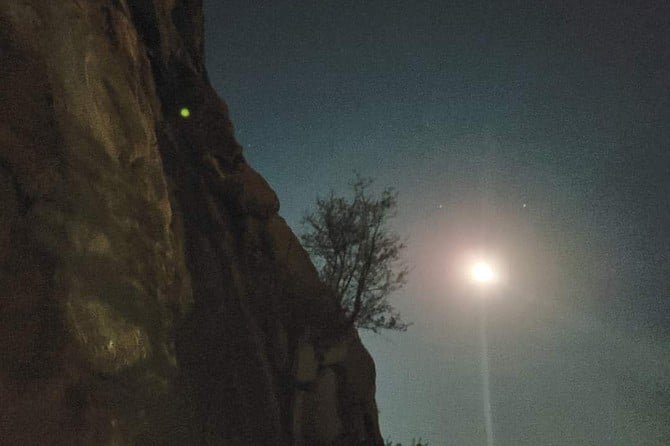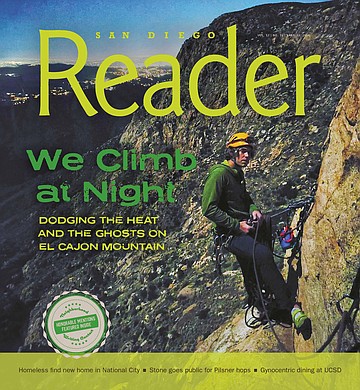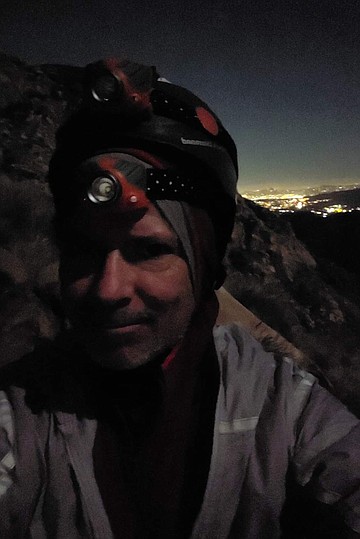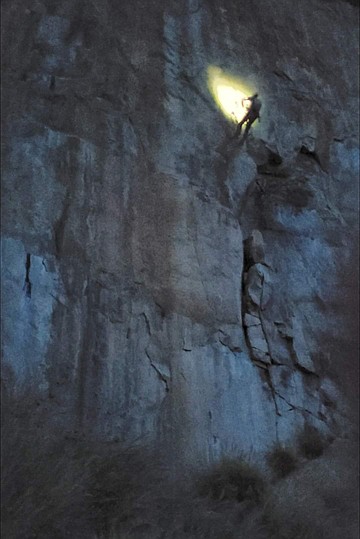 Facebook
Facebook
 X
X
 Instagram
Instagram
 TikTok
TikTok
 Youtube
Youtube

As I make my way up the long and very dark climber’s trail toward El Cajon mountain, I can’t help but think of ghosts. Part of it is the place: there’s another path up to the rock face, and it passes by the ruins of an old miner’s homestead. You can still see the rusty typewriter and decrepit motorcycle left by a past — and probably passed — resident. Part of it is the activity at hand: rock climbing magazines always feature a memorial section honoring my fallen peers, and more than a few of them have died on this mountain.
Most were hikers — part of the reason I’m hiking at night is to avoid heat exhaustion — but there was a climber who decided to ascend without a rope. He fell, nearly taking out several roped climbers as he plummeted from the 500-foot face into the shrubs below. Why would he do that? Climb without a rope, clearly out of his league? And part of it is me. My friend Mike is ahead of me on the trail, smoking while he waits for me to catch up. He has to do that more often these days, as I have fourteen years of living on him.

I call this hike “The Golden Staircase,” because the second half is as steep as a set of stairs, and the boulders are golden-brown — not that you could tell their color right now. There is no moon, and if I turn off my headlight, it’s pitch black. I can’t see a thing, but I’m pretty sure I can hear footsteps off-trail. Ghosts? The summer air is still and hot, but the bugs are not still, and neither are the dogs in the houses below. I don’t mind their barking, but I do mind what it may portend.
Near the bottom of the mountain is an old rock quarry that sits above the dam and reservoir. Climbers use the crumbling, overhanging rock face to practice the skills needed to sleep while suspended from the giant walls in Yosemite. Some of the locals don’t cotton to the climbers, and while it might not be the dog owners below the quarry who express their objections via gunfire, the fact remains that I personally have been sleeping on that wall and heard bullets hit the rock close to my hanging tent.
We climb at night because the rock is too hot to touch during the day in summer, and too full of people during the cooler seasons. At night, there are no foolhardy souls cramming the popular routes, lining up at the bottom waiting for their turn to tackle San Diego’s most spectacular climb. The rock is still warm, but the air is pleasant, and the rattlesnakes along the approach are sleeping. (The dark does bump that approach from two to three hours, but it’s a small price to pay.)
The moon begins to rise as we rack the climbing gear and start our ascent. This route is called Meteor; we think it’s because it is very steep and you climb straight up. Lately, I realized another possibility: while heading east on the 8, I glanced over to the left and saw that when the sun first rises on El Cajon Mountain, the stunning outside corner of the upper part of the climb catches the first rays, and lights up like the streak of a meteor across the sky. Beautiful. But we see no meteors or shooting stars tonight as the moon rises, casting our pale shadows onto the granite face.

I am climbing up first, clipping the bolts and setting the rope through the anchors. My right hand grips a thin edge the width of a pencil, and my left hand is feeling around above me, looking for the next move. I am reading the rock with my fingers like a blind man reading braille. I don’t look up much, just enough to see my headlamp shine on the next safety bolt. I keep my attention on my feet. Each move higher is at least as difficult as the last. Some of the holds have me feeling like I’ve turned over a miniature hourglass, because I must move fast or tire and lose my battle with gravity, which is always working to edge me off my stance, one millimeter at a time. The sands keep on slipping. Time keeps on slipping. I don’t want to slip.
I know Mike sees only a bobbing headlight above him; he can spot nothing indicating either my confidence or my fear. But in any case, climbers talk to each other. “You got me Mike?” I ask, my voice echoing off the walls of the canyon.
“I got you,” he says, his voice reaching up from the darkness one hundred feet below me.

I pause at the shelf halfway up the first pitch and take pictures of the city lights below. I hum the Cat Stevens song “Moonshadow” as I finish the first pitch. Mike quickly follows up on the long first section, his headlight throwing crazy, conflicting shadows on the rock wall. We pause at the ledge before the upper corner to share a smoke and the view. Far below us, the dogs are still barking. Mike starts up his section, and the moon is now so bright that we can almost turn off our headlamps, but we don’t.
Things feel more serious when we rock climb at night, and perhaps they are. We talk to each other more, words of both encouragement and caution. When Mike tops out on the false summit of Meteor, he pulls the rope up, and I follow as quickly as I can. Near the top of the face, there is a breeze. The air is no longer stale; it has the fresh feel of the coast.
At the top of the climb is a perfectly flat shelf, just big enough for two or three people. The 125 freeway snakes away to the south, curving through the county lights on its way to the hills that border Mexico. From up here, we can see it all, all the way to the great dark expanse of the ocean to the west. We’ve earned this view, but we still feel lucky to be here.
To get off, we have to slide down our ropes past an overhang that has us hanging in space, 20 feet from the wall and 150 feet above the base. This part of climbing is the most dangerous — aside from the drive to get to the cliffs. One mistake would mean a fast plunge into the darkness. We don’t make any mistakes, but I think of ghosts again as I start down the trail. It’s now 4 am, and the dogs are still awake. As we near the car, we are treated to the sight of another sort of meteor: a Starlink satellite launch, rolling through the night sky like an interstellar freight train.


As I make my way up the long and very dark climber’s trail toward El Cajon mountain, I can’t help but think of ghosts. Part of it is the place: there’s another path up to the rock face, and it passes by the ruins of an old miner’s homestead. You can still see the rusty typewriter and decrepit motorcycle left by a past — and probably passed — resident. Part of it is the activity at hand: rock climbing magazines always feature a memorial section honoring my fallen peers, and more than a few of them have died on this mountain.
Most were hikers — part of the reason I’m hiking at night is to avoid heat exhaustion — but there was a climber who decided to ascend without a rope. He fell, nearly taking out several roped climbers as he plummeted from the 500-foot face into the shrubs below. Why would he do that? Climb without a rope, clearly out of his league? And part of it is me. My friend Mike is ahead of me on the trail, smoking while he waits for me to catch up. He has to do that more often these days, as I have fourteen years of living on him.

I call this hike “The Golden Staircase,” because the second half is as steep as a set of stairs, and the boulders are golden-brown — not that you could tell their color right now. There is no moon, and if I turn off my headlight, it’s pitch black. I can’t see a thing, but I’m pretty sure I can hear footsteps off-trail. Ghosts? The summer air is still and hot, but the bugs are not still, and neither are the dogs in the houses below. I don’t mind their barking, but I do mind what it may portend.
Near the bottom of the mountain is an old rock quarry that sits above the dam and reservoir. Climbers use the crumbling, overhanging rock face to practice the skills needed to sleep while suspended from the giant walls in Yosemite. Some of the locals don’t cotton to the climbers, and while it might not be the dog owners below the quarry who express their objections via gunfire, the fact remains that I personally have been sleeping on that wall and heard bullets hit the rock close to my hanging tent.
We climb at night because the rock is too hot to touch during the day in summer, and too full of people during the cooler seasons. At night, there are no foolhardy souls cramming the popular routes, lining up at the bottom waiting for their turn to tackle San Diego’s most spectacular climb. The rock is still warm, but the air is pleasant, and the rattlesnakes along the approach are sleeping. (The dark does bump that approach from two to three hours, but it’s a small price to pay.)
The moon begins to rise as we rack the climbing gear and start our ascent. This route is called Meteor; we think it’s because it is very steep and you climb straight up. Lately, I realized another possibility: while heading east on the 8, I glanced over to the left and saw that when the sun first rises on El Cajon Mountain, the stunning outside corner of the upper part of the climb catches the first rays, and lights up like the streak of a meteor across the sky. Beautiful. But we see no meteors or shooting stars tonight as the moon rises, casting our pale shadows onto the granite face.

I am climbing up first, clipping the bolts and setting the rope through the anchors. My right hand grips a thin edge the width of a pencil, and my left hand is feeling around above me, looking for the next move. I am reading the rock with my fingers like a blind man reading braille. I don’t look up much, just enough to see my headlamp shine on the next safety bolt. I keep my attention on my feet. Each move higher is at least as difficult as the last. Some of the holds have me feeling like I’ve turned over a miniature hourglass, because I must move fast or tire and lose my battle with gravity, which is always working to edge me off my stance, one millimeter at a time. The sands keep on slipping. Time keeps on slipping. I don’t want to slip.
I know Mike sees only a bobbing headlight above him; he can spot nothing indicating either my confidence or my fear. But in any case, climbers talk to each other. “You got me Mike?” I ask, my voice echoing off the walls of the canyon.
“I got you,” he says, his voice reaching up from the darkness one hundred feet below me.

I pause at the shelf halfway up the first pitch and take pictures of the city lights below. I hum the Cat Stevens song “Moonshadow” as I finish the first pitch. Mike quickly follows up on the long first section, his headlight throwing crazy, conflicting shadows on the rock wall. We pause at the ledge before the upper corner to share a smoke and the view. Far below us, the dogs are still barking. Mike starts up his section, and the moon is now so bright that we can almost turn off our headlamps, but we don’t.
Things feel more serious when we rock climb at night, and perhaps they are. We talk to each other more, words of both encouragement and caution. When Mike tops out on the false summit of Meteor, he pulls the rope up, and I follow as quickly as I can. Near the top of the face, there is a breeze. The air is no longer stale; it has the fresh feel of the coast.
At the top of the climb is a perfectly flat shelf, just big enough for two or three people. The 125 freeway snakes away to the south, curving through the county lights on its way to the hills that border Mexico. From up here, we can see it all, all the way to the great dark expanse of the ocean to the west. We’ve earned this view, but we still feel lucky to be here.
To get off, we have to slide down our ropes past an overhang that has us hanging in space, 20 feet from the wall and 150 feet above the base. This part of climbing is the most dangerous — aside from the drive to get to the cliffs. One mistake would mean a fast plunge into the darkness. We don’t make any mistakes, but I think of ghosts again as I start down the trail. It’s now 4 am, and the dogs are still awake. As we near the car, we are treated to the sight of another sort of meteor: a Starlink satellite launch, rolling through the night sky like an interstellar freight train.
Comments